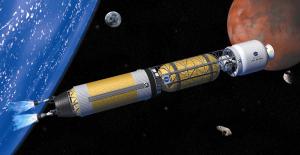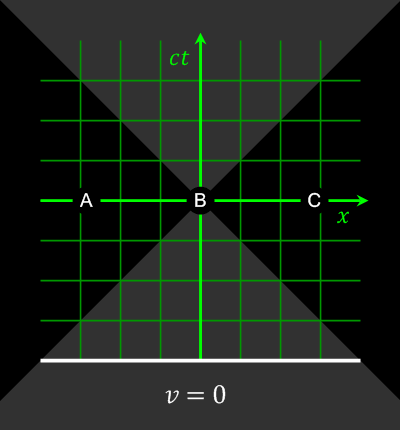Blog
Lunchtime Doubly So
7 May 2015
 NASA
NASAWe live in a universe of space and time. Events occur at a particular time, and in some location in space. In this way, space and time can be seen as a background against which things happen. Throughout most of human history, this background was seen as absolute. Each event occurs at a unique point in space and time, and in principle everyone can agree what that point is. Intuitively, it makes a lot of sense. In our everyday lives the Earth seems to be an unmoving rock, and acts as a point of reference for everything we do. Sure, we now know the Earth moves around the Sun, but it doesn’t feel that way. When Galileo and others began proposing a more sophisticated view of physics, the intuitive view of spacetime as an immutable background remained. Galileo argued that the motion of objects was relative to each other, but that motion could always be measured relative to the “fixed” space. For Galileo, speed was relative, but spacetime was not. When Newton developed his theories of physics and gravity, he also assumed that spacetime was fixed and absolute.
The success of Newton’s physics seemed to confirm the absolute nature of spacetime, and the assumption remained largely unquestioned for two centuries. But as we came to understand light, the idea became less intuitive. According to Maxwell’s equations, the speed of light is the same for all light. That’s because electromagnetic waves propagate at the same rate. But water waves propagate through water, and sound waves through air, so what do light waves propagate through?
The most popular idea was that light moved through a luminiferous aether. This aether couldn’t be observed directly, but it was thought to be stationary relative to the background of space. Some proposed that this aether could in fact be the absolute frame of reference for the universe. But if that’s the case, then your measurement of the speed of light should depend upon your motion relative to the aether.
Suppose you were on the platform of a train moving at 10 m/s (20 mph). If you measured the speed of sound in the direction you are moving, you would get a speed of 330 m/s. That’s because the sound is traveling through the air at 340 m/s, but you are traveling through the air in the same direction at 10 m/s, so the sound is moving 330 m/s relative to you. In the same way, if you measured the speed of sound in the opposite direction, you would get 350 m/s because of your motion. This is a key feature of waves traveling through a medium: they can be different in different directions because of your motion through the medium.
Then in 1887, Albert Michelson and Edward Morley performed an experiment to measure this difference in the speed of light. But what they found was the speed of light was always the same. No matter what direction light traveled, no matter how they oriented their experiment, the speed of light never changed. This was not only surprising, it violated the fundamental assumption of an absolute reference frame. It seemed the speed of light (and only the speed of light) is absolute, and this made no sense at all.
 Wikipedia
WikipediaThis is the puzzle Einstein sought to resolve in “On the Electrodynamics of Moving Bodies.” In this paper Einstein noted that in order for the speed of light to be an absolute constant, either Maxwell’s equations or Newton’s concept of space and time had to be wrong.1 Somewhat surprisingly, Einstein argued for the latter. Specifically, he argued that the “grid” of space and time was relative to the observer. He demonstrated this by looking at a property known as simultaneity. In Newton’s view, two events seen to occur at the same time will be seen to be simultaneous for all observers. But Einstein showed that the constancy of light required this concept of “now” to be relative. Different observers moving at different speeds will disagree on the order of events.
Rather than a fixed background, space and time is a relation between events that depends upon where and when the observer is. This relativity of space and time led to strange predictions, such as time dilation, which were later found to be true. It’s a concept that’s still difficult to fully understand, but is absolutely necessary for modern devices such as GPS.
Tomorrow: Einstein looks at the connection between matter and energy, and finds that relativity could explain the light of the stars.
Einstein, Albert. “Zur elektrodynamik bewegter körper.” Annalen der physik 4 (1905). ↩︎